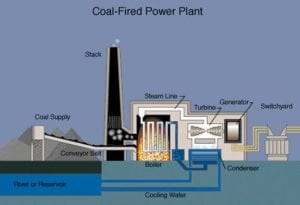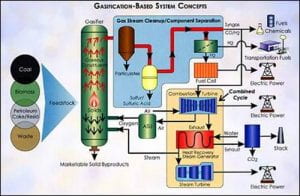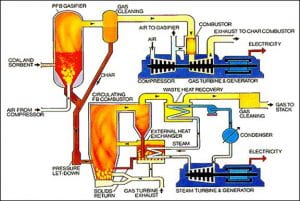The information on this page was prepared by:
| Joseph Ruhl | jruhl@usc.edu | Computer Engineering and Computer Science |
| TianLi Woon | twoon@usc.edu | Electrical Engineering |
Coal: Power Plants
HOW THE PLANTS WORK
Electricity is produced at a coal-fired fossil plant by the process of heating water in a boiler to produce steam. The steam, under tremendous pressure, flows into a turbine, which spins a generator to produce electricity.

http://www.tva.gov/power/coalart.htm
GASIFICATION
Gasification is the conversion hydrocarbon feedstock (e.g. coal, biomass, petroleum, waste) into gaseous components by applying heat under pressure in the presence of steam. The heat and pressure in the chemically break apart the feedstock and set into motion chemical reactions that produce synthesis gas or syngas (primarily hydrogen, carbon monoxide and other gaseous constituents). Syngas can be burned as a fuel in a combustion turbine (see natural gas) to produce electricity. Syngas also has other uses such as:
- As chemical “building blocks” to produce a broad range of liquid or gaseous fuels and chemicals (using processes well established in today’s chemical industry);
- As a fuel producer for highly efficient fuel cells (which run off the hydrogen made in a gasifier) or perhaps in the future, fuel cell-turbine hybrid systems;
- As a source of hydrogen that can be separated from the gas stream and used as a fuel (for example, in President Bush’s hydrogen-powered Freedom Car initiative) or as a feedstock for refineries (which use the hydrogen to upgrade petroleum products).
INTEGRATED GASIFICATION COMBINED CYCLE
IGCC is an innovative electric power generation process that combines modern coal gasification with gas turbine and steam power generation technologies. IGCC is one of the most efficient and cleanest of available technologies for coal-based electric power generation. This technology offers high system efficiencies, low costs, and very low pollution levels.

http://www.fe.doe.gov/programs/powersystems/gasification/howgasificationworks.shtml
FLUIDIZED BED COMBUSTION
Fluidized beds suspend solid fuels on upward-blowing jets of air during the combustion process. The result is a turbulent mixing of gas and solids. The tumbling action, much like a bubbling fluid, provides more effective chemical reactions and heat transfer. The technology burns fuel at temperatures of 1,400 to 1,700 degrees F, well below the threshold where nitrogen oxides form (approximately 2,500 degrees F. The mixing action of the fluidized bed results brings the flue gases into contact with a sulfur-absorbing chemical, such as limestone or dolomite. More than 95 percent of the sulfur pollutants in coal can be captured inside the boiler by the sorbent. The popularity of fluidized bed combustion is due largely to the technology’s fuel flexibility – almost any combustible material, from coal to municipal waste, can be burned – and the capability of meeting sulfur dioxide and nitrogen oxide emission standards without the need for expensive add-on controls.
HYBRID SYSTEMS
In a “hybrid” system, coal is partially gasified in a pressurized gasifier. This produces a fuel gas that can be combusted in a gas turbine. Left behind in the gasifier is a combustible char that can be burned in a fluidized bed combustor or advanced high-temperature furnace to produce steam to drive a steam-turbine power cycle and to heat combustion air for the gas turbine. Heat from the gas turbine exhaust also can be recovered to produce steam for the steam turbine. This highly integrated system of gasifiers, combustors, gas and steam turbines results in a high overall fuel-to-electricity efficiency, exceeding 55 percent in many advanced concepts (the average efficiency of today’s coal-burning power plant typically is around 33-35%). Higher efficiencies mean more affordable electric power for consumers, and because less fuel is required to generate electricity, overall greenhouse gas emissions can be significantly reduced. “hybrid” systems may also lead to less expensive power plants. Because it is not required to break down coal completely into synthetic gas, a partial coal gasifier can be a relatively simple, compact, and low-cost component. The char combustion system likewise can be a relatively low cost module, and unlike many older coal combustors, which are designed to fire a specific type of coal, fluidized bed combustors can accept a wide range of fuels and would have no trouble burning chars produced from a variety of different coals. Because of the lower capital costs and the capability to use relatively low cost fuels, a future “hybrid” power plant might be able to produce electricity at costs 25 percent or more lower than today’s conventional pulverized coal-fired power plants. The gasifier-combustor combination also has numerous environmental advantages. Not only does it produce fewer greenhouse gas emissions (because of increased efficiencies), more that 90 percent of sulfur pollutants emitted from the coal can be captured in the gasifier and combustor by adding sulfur-absorbing limestone. Nitrogen oxide emissions are inherently reduced in a fluidized bed combustor because the ‘fluidizing’ action of the combustion process keeps firing temperatures below the threshold where much of the nitrogen oxides form. With new technology, the fuel gas can be filtered at high temperatures to remove dust and alkalis, avoiding the energy loss of cooling the gas that is necessary in other systems.
The Department’s Office of Fossil Energy has set a goal of developing initial concepts for “hybrid” gasifier-combustor power systems by 2010, with more advanced versions ready for large-scale testing by 2015.
